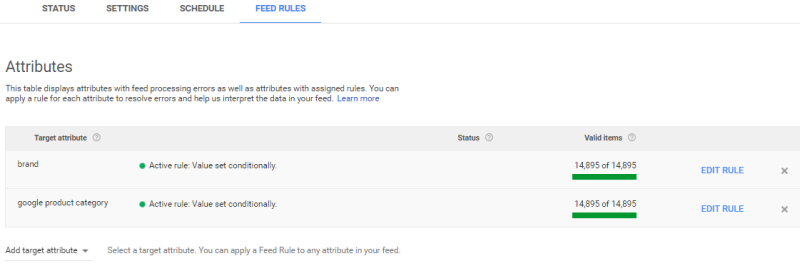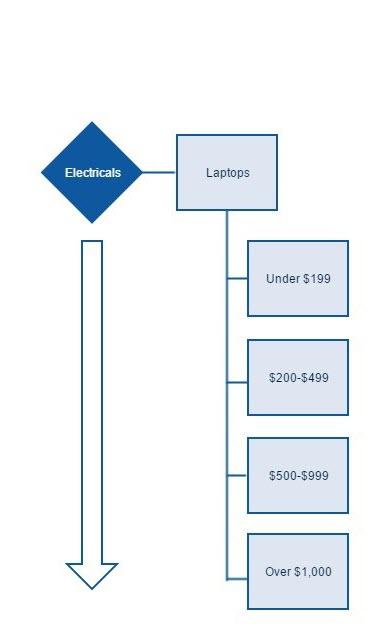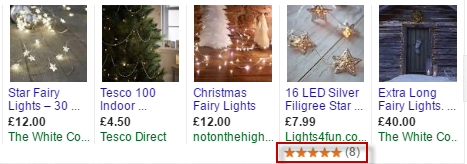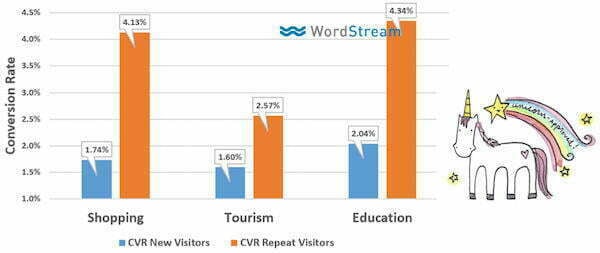
There’s no question that well-executed Google Shopping campaigns can deliver impressive returns. However as more and more advertisers adopt Google Shopping, combined with Google’s initiative to show more shopping ads over the festive season, it can be difficult to stand out from the competition.
Here are six tips to help supercharge your Google Shopping campaigns this holiday season that’ll help drive visibility and returns on your product advertising.
Profitable Google Shopping campaigns don’t build themselves. Download our free guide to Google Shopping and start growing your revenue today!
Optimize Poorer Performing Products
A well optimized product feed is the foundation of successful Google Shopping campaigns and for the festive season, it’s a good opportunity to drive more value out of poorer performing products to shift inventory.
Make sure product titles include as much information as possible within the 150-character limit. This includes the name of the product, brand, gender, size and color. This is good practice that will sit well with merchants serving a variety of industries, from clothing to DIY and furniture.
{Brand} {Product Name} {Gender} {Size} {Colour}
A similar principle applies to product descriptions. Make sure that they contain all the relevant keywords and specific information within the 500-character limit. If you’re selling branded products, there will be a lot of competition. So, write descriptions that highlight the key features of the product. For example, if you’re selling winter coat, is it waterproof? Lightweight? Can sustain up to certain temperatures? It’s all in the detail.
It’s very important that you invest the time into undertaking keyword research when optimizing product titles and descriptions. You’ll soon discover that your customers further into the sales funnel are conducting more granular searches that incorporate colors and sizes into queries. By using more descriptive and keyword focused titles and descriptions, you’re also increasing the chances of your ads showing to searchers at the top and further down the sales funnel.
For inspiration, look beyond AdWords Keyword Planner and use keyword research tools such as Ahrefs, SEMrush and even search terms data in your Google Search Console account.
Keep on Top of Feed Errors & Disapprovals
While it’s clear that any disapproved items in your feed will have an impact on revenue, products with missing fields (flagged as blue and yellow flags in Google Merchant Center) will have not only have an impact on their visibility, but also their competitive edge.
Fortunately to help you identify and resolve feed issues, GMC will not only summarise what products are affected but will also give you the option to download them as an itemised CSV file.
A summary of all product errors and disapprovals can be found in GMC under Products and Diagnostics.
If there are many products with missing fields such as ‘brand’ or ‘google product category’, you can set up Feed Rules in GMC. This will allow you to automatically populate missing fields with either a fixed value, or with variable values based on rules. Perfect for a quick fix.
To set Feed Rules, navigate to Products in GMC, select Feed and then Feed Rules.
RELATED: 8 Perilous PPC Mistakes to Avoid During the Holidays
Blow the Competition Away with Epic Product Images
High-quality and relevant product images will not only help reduce the number of disapprovals in your feed, but will also have a positive impact on your products’ visibility and click-through rates.
For clothing items, be sure to use quality 250 x 250px images and 100 x 100px for non-clothing items. Also, remove any layered promotional text or marks that may be obscuring the view of products.
Finally, consider using alternatives to manufacturer stock images. For example, use contextual product imagery that shows the item in situ, or show the product from different angles. This helps your product stand out in competitive branded item results.
Leverage Custom Labels for Efficient Spending & Reporting
I’ve come across many AdWords shopping campaigns structured as a single campaign with a single ad group containing a crazy number of product groups. This campaign structure puts a huge limitation on your bidding strategy and reporting.
Custom labels allow you to divide out products by a value of your choosing that’s beyond the feed fields such as brand and product type. Once applied, you can structure your Google Shopping campaigns that will provide more control over spend.
A typical example of a custom label would be to identify your best-selling products. If best sellers are mixed with poorer performing products in a single campaign, you’ll find yourself limited by budget and unable to bid more aggressively on best sellers independently. This will restrict the visibility of best sellers, will drive up the CPA of lower priority items and skew your reporting metrics.
By creating a separate campaign for best-sellers, you’re able to set an individual budget with a specific bidding strategy to help secure maximum visibility of products that are going to make you a sweet return. It will also allow you to set a campaign priority should you have a product in multiple campaigns such as brands and best-sellers.
It’s not just popularity either. You can use custom labels to set up individual campaigns for products by:
- Price range
- Profit margin
- Festive sale items
- Stock levels
- Seasonality
Stand Out with Product Ratings
In competitive product search markets, it’s important that you take advantage of techniques that will help make your ads standout. To grab the attention of searchers, take the opportunity to enable product ratings in combination with descriptive titles and striking product images.
Why push for product ratings?
- They provide positive reinforcement on the buyer’s decision making
- Help your ads stand out against the competitor products without seller ratings
- Contributes to driving Quality Score which means higher visibility and lower CPC
Not to be confused with seller ratings that appear alongside text ads, product rating stars will trigger once you have a minimum of 3 reviews for a product, and 50 reviews in total across all your product offering.
To get started with product ratings, submit Google’s Product Ratings Interest Form and they will be touch with you once they’ve reviewed the information that you’ve provided on the form. If you already use a third-party review service provider such as Feefo and Trust Pilot, it will make the process of securing product ratings much easier.
Capture Familiar Audiences with Remarketing Lists
Much like search ads, you can adopt remarketing lists (RLSAs) for your shopping campaigns too. This is great technique that’ll allow you to customise bids to previous visitor audiences. This would include shopping cart abandoners, returning visitors and previous buyers.
With the flexibility to bid more aggressively on specific audiences that are familiar with your brand and products, remarketing lists for shopping ads have the potential to do wonders for your shopping campaigns. This includes higher click throughs and conversion rates, as well as contributing to lowering your CPA too with generally lower CPC.
Do you have any Google Shopping tips for the holiday season?
About the Author
Tom Whiley is a Digital Marketing Consultant at Hallam. Working in a consulting capacity at Hallam, Tom specialises in search engine marketing and is passionate about lead generation for brands and businesses.
Twitter: https://twitter.com/TWhiley
LinkedIn: https://uk.linkedin.com/in/tomwhiley













